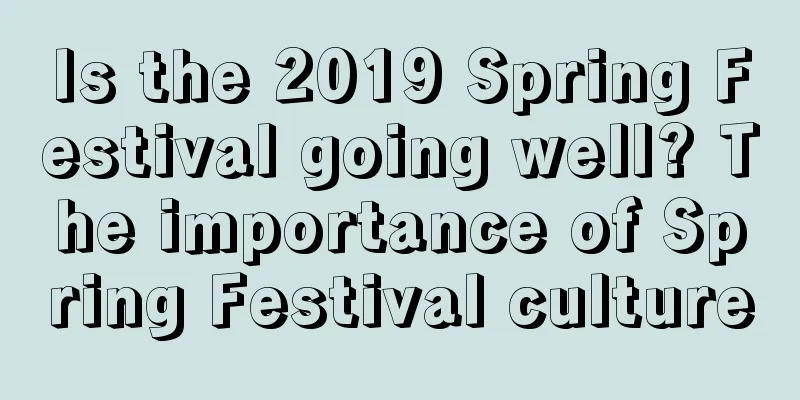Let us show you the Spring Festival customs of different ethnic groups in China!

Introduction: Our country is a typical multi-ethnic cultural country, so it has rich and colorful folk culture and customs. The Spring Festival is an important festival in our country, so there are differences in Spring Festival customs among different ethnic groups. So how does each ethnic group celebrate the Spring Festival? Let’s experience it together with the editor. In addition to the grand and festive celebrations of the Spring Festival, we also need to pay attention to some taboos regarding the Spring Festival. Next, let’s take a closer look at the Spring Festival special topic compiled by Mr. Shui Mo!Han nationality:From the 23rd day of the twelfth lunar month to New Year's Eve, people call this period of time "Welcoming Spring Day" or "Dust Sweeping Day". Sweeping the house and keeping clean before the Spring Festival is a traditional custom. About ten days before the festival, every household prepares New Year's goods, including chicken, duck, fish, meat, tea, wine, oil, sauce, fried nuts from the north and south, sweets, baits and fruits. They have to buy enough of them, and also prepare some gifts to give to relatives and friends when visiting during the New Year. Children have to buy new clothes and hats to wear during the New Year. Before the festival, people would paste Spring Festival couplets on the front doors of their houses, put up colorful and auspicious New Year pictures in the house, hang big red lanterns or paste the word "Fu" and images of the God of Wealth and door gods in front of the doors.After the New Year's bell rings, firecrackers blast in the streets, the sounds echo one after another, and every family is filled with joy. The new year has begun, and men, women, old and young all wear festive attire. They first pay New Year's greetings to the elders in the family and wish them a happy birthday. During the festival, children are given New Year's money and a family reunion dinner is eaten. On the second and third days of the New Year, people start visiting relatives and friends, paying New Year's greetings to each other, expressing congratulations and blessings, saying congratulations on the new year, congratulations on making a fortune, congratulations, happy New Year, etc., and they also worship their ancestors and perform other activities. Zhuang Nationality:On the night of New Year’s Eve, every household would light a big fire on their fire pit which would stay burning all night long. This was called “welcoming the new fire”. It is a folk custom to make rice dumplings during the Spring Festival. During the festival, a variety of ethnic cultural and sports activities are organized to celebrate, including singing "Picking Tea", lion and dragon dances, shoulder-pole dances, gong sounds, spinning tops, ball games, and local opera performances.Zhuang Nationality Spring Festival Customs: Welcoming Heroes: The Zhuang ethnic group living in southern China congratulates everyone they meet when they go out on the Spring Festival, believing that this will ensure a prosperous year. The Zhuang people have the custom of celebrating old age, which they call "eating Lijie". "Chilijie" is on the 30th of this month. According to legend, more than 100 years ago, a peasant armed force of the Zhuang ethnic group returned triumphantly after fighting against foreign invaders. By then, the Spring Festival had passed. In order to welcome them, the Zhuang people celebrated the Spring Festival for them again on the 30th of this month. Manchu:As the Lunar New Year approaches, every family cleans their courtyard and puts up window decorations, couplets and the word "Fu". On the 30th day of the twelfth lunar month, every household erects a lantern pole more than six meters high, and from the first to the sixteenth day, red lanterns are hung every day. When making dumplings on New Year’s Eve, it is important that the more folds the better. The dumplings are cooked at midnight and some have copper coins stuffed inside for good luck to whoever eats them. People worship twice during the Spring Festival, once on the night of New Year’s Eve to bid farewell to the old year, and once again on the first day of the New Year to welcome the new year. Before the Spring Festival, competitions such as horse jumping and camel jumping are held. There is also a lantern festival on the fifteenth day of the first lunar month.The Manchus were divided into four banners: red, yellow, blue and white. During the Spring Festival, people with red flags put red flags on their doors, people with yellow flags put yellow flags on their doors, people with blue flags put blue flags on their doors, and people with white flags put white flags on their doors. These hanging flags have beautiful patterns and bright colors, symbolizing an auspicious beginning to the year. During the festival, boys gather in groups to set off firecrackers or ride on various homemade wooden sleds, whizzing across hills and ice. Young girls and young wives, wearing newly made flowery clothes, gathered in groups of three or five and played Kalaha (pig or cow knee bones) together. From the first to the fifth night of the New Year, people voluntarily organize themselves to dance the yangge to celebrate the new year. The stronger yangge teams not only dance in their own village, but also go to other villages to dance. The onlookers often laughed so hard that they laughed and forgot about their fatigue and coldness. There were even enthusiastic spectators who followed the yangko team from village to village and did not return until dawn. Hui Nationality:When making dumplings on New Year’s Eve, on this day one has to close the “mouth” of those who like to gossip. Serve the hot dumplings, open the pre-prepared Laba vinegar, and the whole family sits together at the table, laughing and having fun! However, children are more interested in the various snacks on the table. The fruit shells can be thrown all over the floor, and they cannot be swept on the night of the 30th, which is called "smashing the year".On the day of the Spring Festival, the sound of firecrackers resounded through the sky. Children wore brand new clothes, and girls put rosy makeup on their faces, put small red dots between their eyebrows, and tied red knots on their heads. They ran around, making the scene very lively. The adults were delighted and congratulated each other and wished each other a happy new year. The New Year’s Eve dinner is extremely sumptuous at noon, but at night people eat noodles or dumplings, which symbolize harmony, reunion and happiness in the new year. Dai people: Throwing rice bran bagsYoung Dai men and women love to play the game of throwing bran bags. During the Spring Festival, boys and girls throw bran bags to each other to see who can throw more accurately and who can catch it. After playing for a while, the girls would secretly snatch the sword, head cloth or tied horse from the boy and run back home. If the young man has feelings, he will follow. When the parents saw their daughter coming back with a headscarf and leading a fine horse, they held a banquet to entertain her. In addition, April 13th of each year is the Dai New Year, which is also the most important festival of the Dai people - the Water Splashing Festival. They regard water splashing as a symbol of exorcising evil spirits and removing dirt, as well as good luck and fortune, and also regard this day as the most beautiful and auspicious day.Summary: Through the above content, we have gained a certain understanding of the Spring Festival customs among different ethnic groups, and also felt the characteristics of the Spring Festival of different ethnic groups. I hope everyone will like these contents. I wish you all good luck and all the best in the new year! After reading this article, there are more exciting content in the Spring Festival special topic, let’s take a look! |
Recommend
The 26th day of the seventh lunar month in 2020
An overview of the auspicious and inauspicious ev...
The fate of boys born on the fifth day of the eighth lunar month in 2021
In mid-autumn August, sweet osmanthus flowers are ...
Is it auspicious to get engaged the day after Laba Festival in 2020? Is the hexagram on January 3rd an excellent one?
Introduction: Different days have good and bad luc...
Why can’t you get a haircut in the first month of the lunar year? Is it true that getting a haircut in the first month of the lunar year will lead to the death of one's uncle?
There is a taboo among the people that you cannot ...
Is Xiaoxue born on November 22, 2020 a pure Yin or pure Yang person?
There are numerous theories about the eight charac...
Can we visit the graves and pay homage to our ancestors on the 17th day of the seventh lunar month in 2019? What are the rules for paying homage to our ancestors?
Introduction: Visiting graves and paying homage to...
Is it a good time to get a haircut on the fifth day of the sixth lunar month in 2018? What is the date like?
Introduction: The fragrance of lotus brings the br...
What is the fate of a baby born in August of the lunar calendar in 2022? Which day is the best for life?
What is the fate of a baby born in August of the l...
What are some proverbs about the Dragon Raising its Head on February 2? Collection of Proverbs
The second day of the second lunar month is said t...
Where is the God of Wealth on the 12th day of the 9th lunar month in 2020?
Where is the God of Wealth on the 12th day of the...
Is the twelfth day of the third lunar month in 2019 a suitable day for a haircut? Check today’s auspiciousness and inauspiciousness!
Introduction: Sometimes you have to choose an ausp...
Can we say Happy Winter Solstice on Winter Solstice? How to say blessings and greetings during the Winter Solstice?
The winter solstice is the day with the longest ni...
Where is the best place to take children to travel during the Dragon Boat Festival in 2018?
Introduction: The Dragon Boat Festival is both a t...
What day is October 17th in the lunar calendar 2017? What month and date is it?
In early winter, October, you begin to feel a lit...
Analysis of the lunar calendar for the second day of April in 2020: good or bad days
Daily almanac content: good and bad things, dos a...









